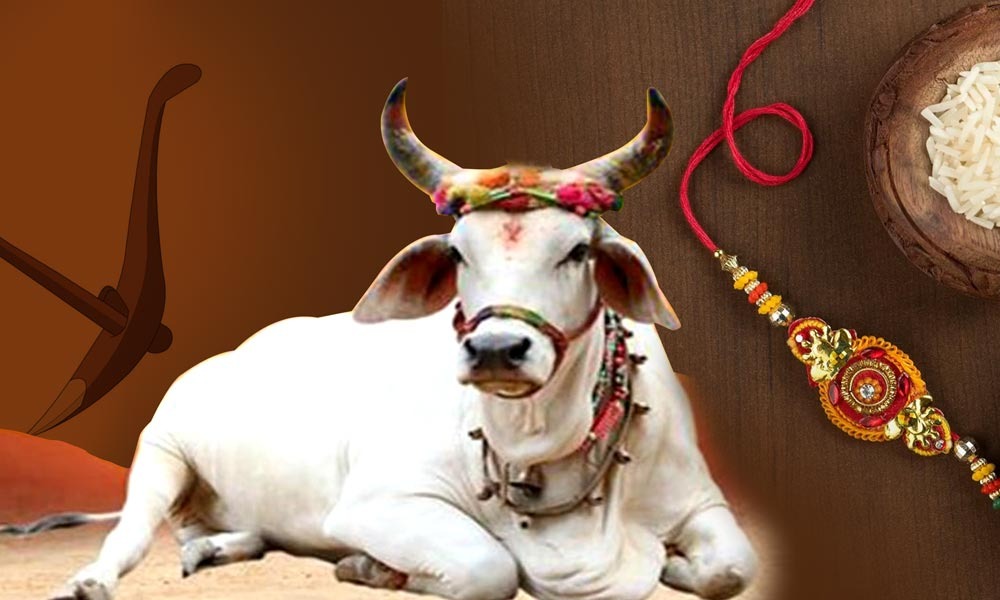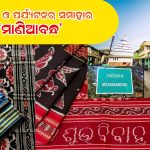Gamha Purnima, also known as Balabhadra Jayanti, is celebrated in the month of Shravan in Odisha and several parts of India on the full moon day (or Purnima). What is so special about this occasion? While most people around the world know this day as Rakhi or Raksha Bandhan, it is also the birthday of Lord Balabhadra, the older sibling of Lord Jagannath.Gamha Purnima 2022 will be celebrated on 11th August.
A Festival Celebrating Cattle & Agriculture
Lord Balabhadra, also hailed as Haladhara, the one who carries the plough as his weapon, is the Lord of agriculture. Religious scriptures even narrate stories about how Lord Balabhadra was the one who invented the plough and blessed mankind with the methods of agriculture.
This festival thus involves various rituals conducted by farmers and cattle bearers. These rituals include the following:
- Cleaning the cattle-shed and neatly plastering it. It is followed by decorating the place with sketches of ploughs and other agricultural equipment.
- Bullocks are the centre of all agricultural activities. They are bathed well and then decorated with flowers and sandal-paste. Their horns are also oiled.
- Finally, a small puja takes place in honour of the bullocks and the agricultural implements. The bullocks are worshipped in the cattle-shed itself, where a new piece of cloth is placed on its back. They are also fed pulses and rice-cakes.
Gamha Diyan: The Highlight of the Day
The spiritual and ritualistic beginning of the day moves towards a celebratory evening. Agriculturists from a particular area gather around at a common place. Here, each bullock is made to jump over an altar known as Gamha Bedi. This part of the day is called Gamha Diya. Let’s take a deeper look at the ritual:
Gamha is a platform constructed from mud and bricks with a large elevation in the centre. On the opposing sides of the main projection, there are two large poles placed into the Gamha. A bamboo stick connects these poles.
Various fruits and prizes are hanged for participants from the bamboo stick. The competitors rush into the Gamha and throw themselves towards the prize dangling from the bamboo pole using the central projection of the Gamha as a launch pad. The one who touches the prize is awarded. This festival is considered to be reminiscent of a similar festival in which Lord Balabhadra took part himself and also ploughed the lands with his bullocks.
Raksha Bandhan Celebrations in the Modern Day
In the urban side of the state, people take the occasion to celebrate Raksha Bandhan, the auspicious day of tying a thread (or Rakhi) on your brother’s wrist in exchange for a promise of protection.
According to religious texts, Kunti, the Pandavas’ mother, gave Lord Krishna the responsibility for her sons’ safety on this day because the Kauravas intended to kill them. As a result, the event continues to this day and is known as Rakshya Purnima, or the full-moon day of protection.
How do you Celebrate this auspicious day?
The pious day of purnima has different meanings, beliefs and stories associated with it. Be it Rakhi or Gamha Purnima, it brings good luck, prosperity and a time of merrymaking in families. Share your stories about celebrating Raksha Bandhan / Gamha Purnima in the comments below.
Gamha Purnima, also known as Balabhadra Jayanti, is celebrated in the month of Shravan in Odisha and several parts of India on the full moon day (or Purnima). What is so special about this occasion? While most people around the world know this day as Rakhi or Raksha Bandhan, it is also the birthday of Lord Balabhadra, the older sibling of Lord Jagannath.Gamha Purnima 2022 will be celebrated on 11th August.
A Festival Celebrating Cattle & Agriculture
Lord Balabhadra, also hailed as Haladhara, the one who carries the plough as his weapon, is the Lord of agriculture. Religious scriptures even narrate stories about how Lord Balabhadra was the one who invented the plough and blessed mankind with the methods of agriculture.
This festival thus involves various rituals conducted by farmers and cattle bearers. These rituals include the following:
- Cleaning the cattle-shed and neatly plastering it. It is followed by decorating the place with sketches of ploughs and other agricultural equipment.
- Bullocks are the centre of all agricultural activities. They are bathed well and then decorated with flowers and sandal-paste. Their horns are also oiled.
- Finally, a small puja takes place in honour of the bullocks and the agricultural implements. The bullocks are worshipped in the cattle-shed itself, where a new piece of cloth is placed on its back. They are also fed pulses and rice-cakes.
Gamha Diyan: The Highlight of the Day
The spiritual and ritualistic beginning of the day moves towards a celebratory evening. Agriculturists from a particular area gather around at a common place. Here, each bullock is made to jump over an altar known as Gamha Bedi. This part of the day is called Gamha Diya. Let’s take a deeper look at the ritual:
Gamha is a platform constructed from mud and bricks with a large elevation in the centre. On the opposing sides of the main projection, there are two large poles placed into the Gamha. A bamboo stick connects these poles.
Various fruits and prizes are hanged for participants from the bamboo stick. The competitors rush into the Gamha and throw themselves towards the prize dangling from the bamboo pole using the central projection of the Gamha as a launch pad. The one who touches the prize is awarded. This festival is considered to be reminiscent of a similar festival in which Lord Balabhadra took part himself and also ploughed the lands with his bullocks.
Raksha Bandhan Celebrations in the Modern Day
In the urban side of the state, people take the occasion to celebrate Raksha Bandhan, the auspicious day of tying a thread (or Rakhi) on your brother’s wrist in exchange for a promise of protection.
According to religious texts, Kunti, the Pandavas’ mother, gave Lord Krishna the responsibility for her sons’ safety on this day because the Kauravas intended to kill them. As a result, the event continues to this day and is known as Rakshya Purnima, or the full-moon day of protection.
How do you Celebrate this auspicious day?
The pious day of purnima has different meanings, beliefs and stories associated with it. Be it Rakhi or Gamha Purnima, it brings good luck, prosperity and a time of merrymaking in families. Share your stories about celebrating Raksha Bandhan / Gamha Purnima in the comments below.




